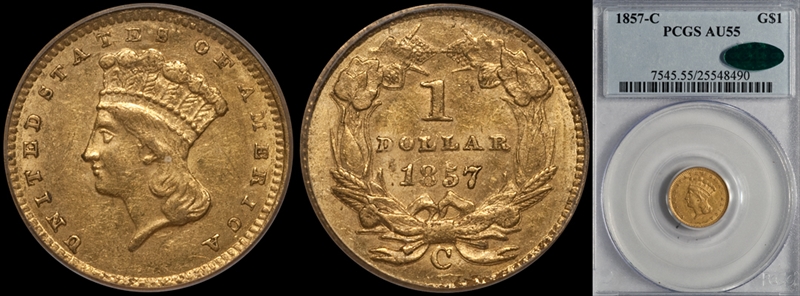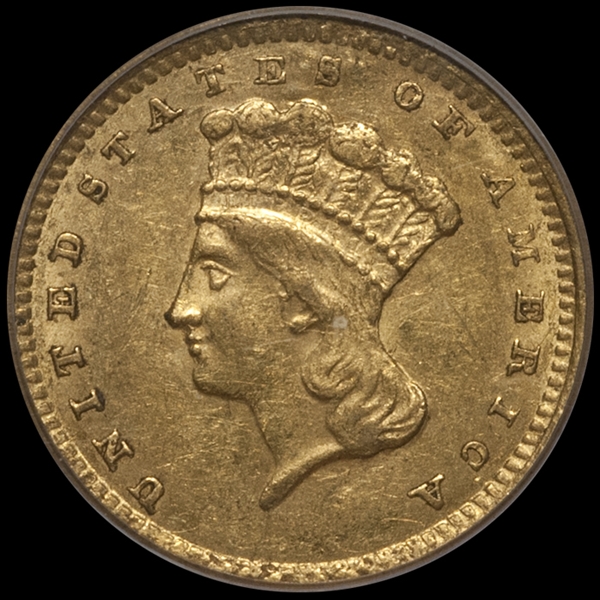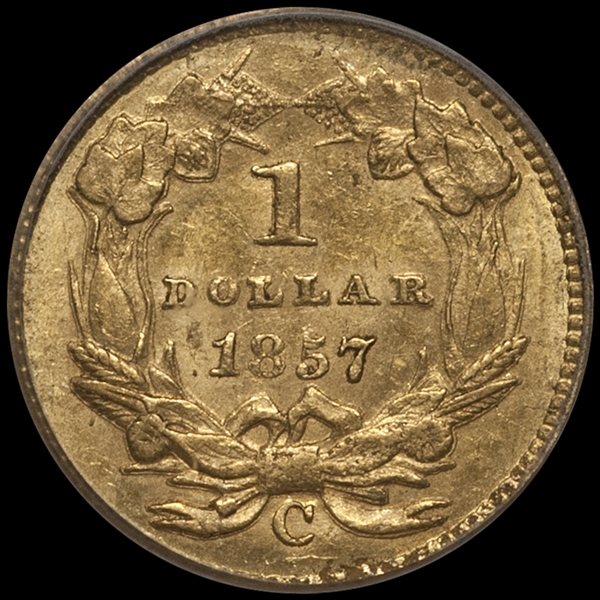1857-C G$1 AU55 认证号25548490, PCGS号7545
拥有者评论
The redesign of the gold dollar did little to improve the quality of the 1857 issue as it is one of the poorest manufactured coins ever issued by a U. S mint. Most specimens are made with inferior dies and badly produced planchets. Virtually all examples exhibit weak, incomplete strikes with flat to little lustre. The present example is one of the better produced coins with a fairly good strike with some lustre enhanced by golden toning in the fields. This is about as attractive as this issues gets, which isn't saying much.
专家评论
David Akers (1975/88)
The planchets used for striking 1857-C gold dollars were downright attrocious, as was the quality of minting. Even the best available specimens look terrible, and are very difficult to grade. Once again, one must look at the quality of the surfaces and the mint lustre rather than at the typical grading points that one would examine on say an 1857. Because even uncirculated specimens generally have such poor appearance, they rarely bring prices that are commensurate with their true rarity. For example, the Unc. Niewoehner specimen brought only $1,100, and yet it was the first uncirculated 1857-C offered at auction in eight years.Doug Winter
By 1855, Mint officials were ready to admit that the Type Two gold dollar was a failure. Accordingly, Mint Engraver James Longacre began to work on a new design that was adopted on January 1, 1856. The diameter was not changed. The Indian Princess design was made broader and placed closer to the border. The relief details were lowered in an attempt to make the strike sharper on both the obverse and the reverse.The 1857-C is the more common of the two Type Three Charlotte gold dollars. It is typically seen in Very Fine and Extremely Fine grades. It is a very scarce issue in properly graded About Uncirculated with most examples grading no better than AU50 to AU53. The 1857-C is rare in AU55 and very rare in properly graded AU58. In Mint State, It is among the rarest Charlotte gold dollars. I am aware of only two or three that I consider to be legitimately Mint State and none of these are especially choice.
Production of the new coins, known to numismatists as Type Three gold dollars, began at Philadelphia, San Francisco and Dahlonega in 1856. No gold dollars were produced at the Charlotte Mint until 1857. The new design proved no more successful than the old Type Two. In fact for Charlotte coins, the quality of the strike is as bad for the 1857-C (and 1859-C) as it is for the 1855-C.
STRIKE: The 1857-C gold dollar generally shows a very poor strike. The hair is quite weak with many areas showing no definition whatsoever. The plumes are very faint while the feathers are sharper than one might expect. The border shows weakness on the denticles but most are present. On the reverse, the wreath shows better detail at the top at the bottom. The bow knot tends to be particularly weak and this is often mistaken for wear. The date is usually weak on the 85 while the OL in DOLLAR is blurry. The denticles are less defined than on the obverse and they may show noticeable areas of die rust. I have never seen an example that I considered to be sharply struck.
SURFACES: This issue is almost always found with severe mint-made planchet defects. The obverse fields have an irregular almost “wavy” look while the reverse is frequently very rough at the center. I have seen many 1857-C gold dollars with what appear to be “strips” of roughness around the head of Liberty. There are a few known with reasonably choice surfaces and these are very rare.
LUSTER: Very few examples show any mint luster. On the few that I have seen that do, it is dull and grainy in its texture.
COLORATION: The coloration of original examples ranges from rich green-gold to a medium orange-gold hue. As recently as a few years ago it was possible to locate an 1857-C gold dollar with natural color but it is almost impossible today as most have been dipped and brightened.
EYE APPEAL: This is among the hardest Charlotte coins of any denomination to locate with good eye appeal. Nearly every known example is poorly struck and is found with numerous planchet irregularities. Any piece with better than average eye appeal is very rare and should command a strong premium over a typical example.
DIE CHARACTERISTICS: An area of the die polish near the ear hole can be seen on higher grade coins.
DIE VARIETIES: There is a single variety known.
Variety 1 (formerly Variety 10-M): The word DOLLAR is strongly doubled. The date is placed low in the field and it slants noticeably downwards with the 7 much lower than the 5. The mintmark is placed high near the bow knot.
PCGS #
7545
设计师
James Barton Longacre
边缘
Reeded
直径
14.30 毫米
重量
1.70 克
铸币数量
13280
金属成分
90% Gold, 10% Copper
更高评级数量
17
评级较低的钱币数量
147
地区
The United States of America
价格指南
PCGS 数量报告
拍卖 - PCGS 评级的
拍卖 - NGC 评级的
稀有性和存量估计 了解更多
| 所有评级 | 175 |
| 60或以上 | 3 |
| 65或以上 | 0 |
| 所有评级 | R-7.2 |
| 60或以上 | R-9.8 |
| 65或以上 | R-10.1 |
| 所有评级 | 15 / 49 TIE |
| 60或以上 | 1 / 49 |
| 65或以上 | 1 / 49 |
| 所有评级 | 25 / 81 TIE |
| 60或以上 | 2 / 81 TIE |
| 65或以上 | 1 / 81 |
状况普查 了解更多
| #1 MS61 PCGS grade |
| #2 MS60 PCGS grade |
| #3 AU58 PCGS grade |
| #3 AU58 PCGS grade |
| #3 AU58 PCGS grade |






















